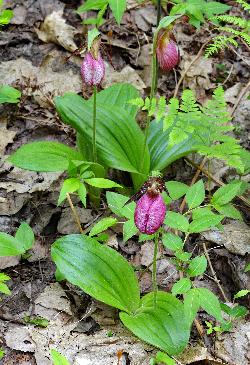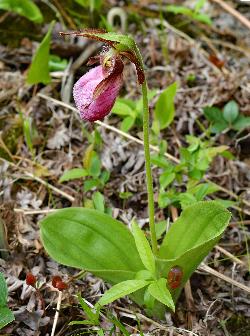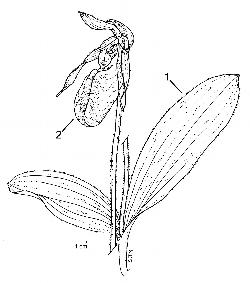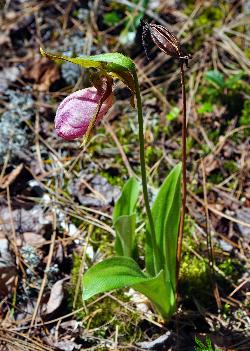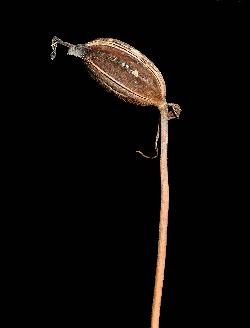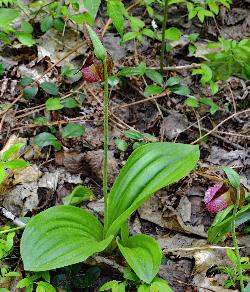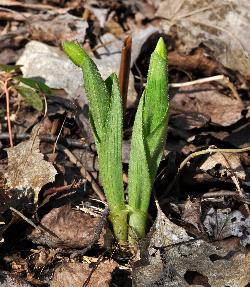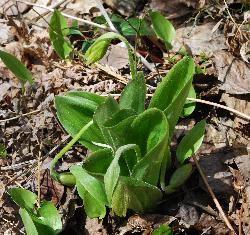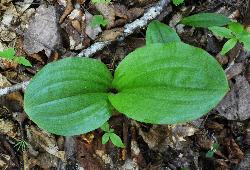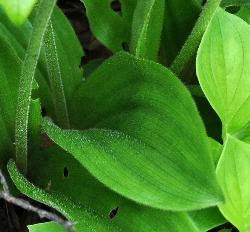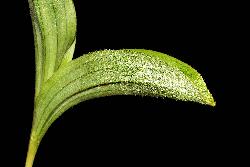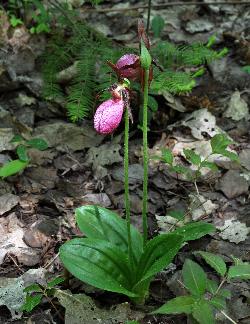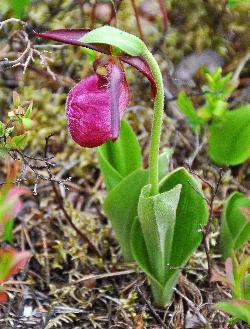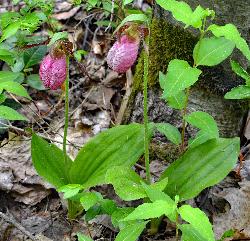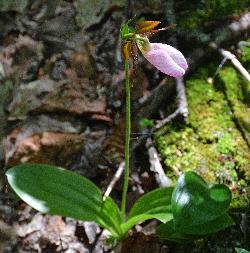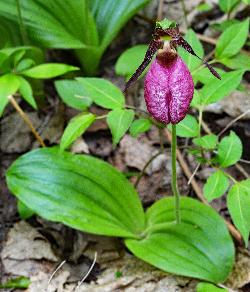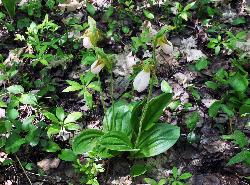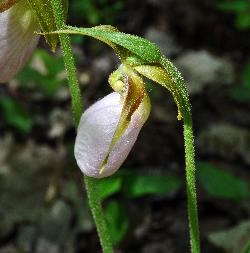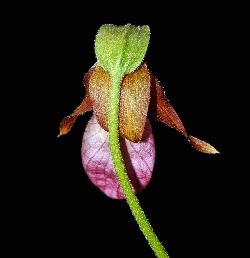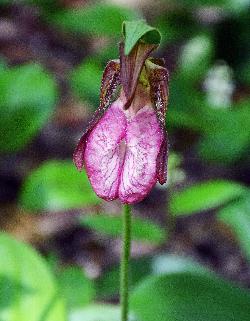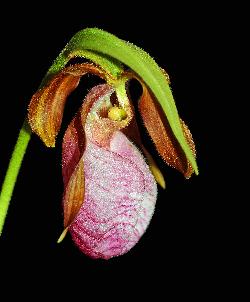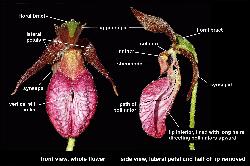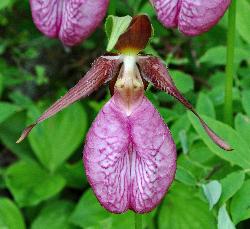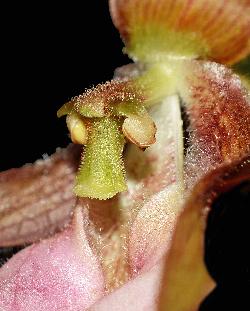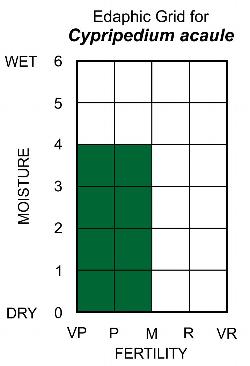Fr: cypripède acaule, cypripède rose, sabot de la vierge
Orchidaceae - Orchid Family
Note: Numbers provided in square brackets in the text refer to the image presented above; image numbers are displayed to the lower left of each image.
General: A long-lived, perennial woodland forb of acidic soils, 1.5–6 dm tall, with basal leaves and an erect scape that bears a single pink-lipped showy flower [1–2]. Pink ladyslipper is the Provincial floral emblem for Prince Edward Island. As with most orchids, pink ladyslippers depend on a mycorrhizal relationship with a soil fungus to grow successfully, thus orchids should not be transplanted, as they will not persist without the right soil type, pH, and mycorrhizal fungus. In their natural habitat, pink ladyslipper plants can persist for 20+ years (Ruta McGhan 2016). Warning: Floral bracts, leaves, and scapes of Cypripedium acaule plants contain a toxic quinone, cypripedin, which can cause contact dermatitis (blistering rashes) in sensitive people (Reddoch and Reddoch 1984, Munro 2015).
Key Features: (numbers 1–2 refer to the illustration [3])
- Leaves basal, 2 (on flowering plants, 1–2 on sterile plant), simple, and pubescent, with elliptic to obovate blades, 9–30 cm long, tapering to the base and the acute to obtuse apex; margins are entire. Several slender veins occur between each of the 5–7 prominent parallel veins.
- A solitary nodding flowers with a thin conspicuous pouch-like pink lip (rarely white) and yellowish-green to reddish-brown sepals and lateral petals. The two laterals sepals are fused in a synsepal that subtends the lip.
- The fruit is a dry ellipsoid capsule [4–5], but fruits do not often develop; old scapes can be recognized by the lanceolate-acuminate floral bract that persists at the top of the scape [6].
Stems: Pink ladyslipper orchids lack leafy above-ground stems; plants develop annually from perennial rhizomes, producing basal leaves and a single flowering stem (scape) that is densely glandular-pubescent. Colonies, when present, are produced from vegetative propagation of one or more rhizomes and may be very large, containing hundreds of flowering plants (Correll 1950), although most colonies have scattered or few plants.
Leaves: Simple, basal, 2 on flowering plants, often 1 on non-flowering plants (Reddoch & Reddoch 1997). Emerging leaves are erect [7–8], but become spreading to horizontal with maturity [10]. Leaf blades are elliptic, oblong, or obovate [9], 9–30 cm long by 2.5–15 cm wide, taper gradually to the base and the acute to obtuse apex, and have entire margins. Both leaf surfaces are glandular-pubescent, and margins are entire [10]. Venation is parallel, with several slender veins occurring between each of the 5–7 veins, depressed on the upper surface, prominent on the lower surface [11].
Flowers: Bisexual, solitary (rarely 2), somewhat fragrant, nodding, and borne on a sturdy densely glandular-pubescent scape [12–14]. Each flower is subtended by a green, 4–5 cm long, lanceolate, acuminate floral bract that arches over the flower [15]; the bract and all parts of the flower are somewhat pubescent. Flowers typically have reddish-brown sepals and lateral petals, while the large pale pink to deep pink lip is obovoid, 3–6.7 cm long, thin, and pouch-like [16–17]. Albino (acyanic) forms have greenish-yellow sepals and petals and a white lip that may have a faint pink or greenish blush [18–20]. In all Cypripedium species, the 2 lateral sepals are fused together, forming a synsepal that subtends the large lip [21]. The upper (dorsal) sepal is elliptic, lanceolate, or lanceolate-ovate, measures 1.9–5.2 cm long by 0.5–2.2 cm wide, and arches over the column [22]; the synsepal is similar in shape, but slightly smaller, 1.7–4.9 mm long. The apex of the synsepal is usually acute, but may be slightly divided into a 2-pronged tip. The lateral petals are spreading, linear-lanceolate, 2.4–6 cm long by 0.4–1.7 mm wide, and either flat or slightly twisted [22–23].
The two sides of the lip curve inward and meet along the centre, but do not fuse; the adjacent margins form a vertical slit in the upper surface of the lip through which pollinators can enter. The area along the vertical slit is often white and marked with pink veins, directing pollinators toward the lip opening [24–25]. The column supports 2 globose yellow anthers, each of which contain a sticky mass of pollen grains (pollinia), and terminates in a prominent shield-shaped staminode [26], greenish-brown to reddish-brown, and up to 1.8 cm long. The staminode arches forward, covering the anthers, stigma, and opening between the lip margins, which are only fully visible with the staminode removed [27]. The inferior ovary is cylindrical to ovoid, 3-celled, and covered with short stipitate-glandular hairs.
Pollination is by bumblebees (entomophily), with the pollinator entering the lip through the vertical slit. Once inside, the bee cannot exit the lip through the slit due to its incurved margins, so must pass beneath the stigma of the column and exit through a small opening adjacent to the base of the column (Correll 1950, Davis 1986). Long hairs along the petal bases and inside of the lip divert the pollinator to one of the openings on either side of column base, where the bumblebee then comes in contact with an anther. One of the two pollinia becomes attached to the thorax of the pollinator as it squeezes past the anther to exit the lip. If a bumblebee is already adorned with pollen, a pollinium will be inadvertently inserted into the stigma as the bee passes under the column; it may then pick up another pollen mass during its escape from the flower. Although pink ladyslipper flowers are self-fertile, their floral anatomy ensures that flowers are cross pollinated, as pollen is dislodged from the anther only after the pollinator passes under the stigma (Davis 1986).
Effective pollinators of the pink ladyslipper have been identified by Stoutamire (1967), Plowright et al. (1980), and Davis (1986) as queens of the genus Bombus, including the half-black bumblebee, B. vagans Smith, 1854, and the northern amber bumblebee, B. borealis (Kirby, 1837), as well as queens of the cuckoo bumblebee, B. ashtoni (Cresson, 1864), formerly in the genus Psithyrus. In the New Brunswick study by Barrett & Helenurm (1986), no pollinators were observed within the study area visiting pink ladyslipper flowers, but pollinia from this orchid were found on 2 collected queen bumblebees (B. vagans). Other insects may visit Cypripedium acaule flowers, but are not large enough to dislodge the pollinia, thus are not considered effective pollinators.
Nectar is lacking, as is any reward to the pollinator, since pollen cannot be collected by bumblebees in a manner that would allow them to consume it, but bumblebees are probably attracted by the colour and fragrance of these deceptive orchid flowers (Stoutamire 1967, Davis 1986). However, once a pollinator identifies a specific type of flower as lacking in reward, it will avoid these flowers in favour of flowers that do produce rewards of nectar or pollen (Davis 1986, O’Connell and Johnston 1998). Avoidance by pollinators of non-rewarding flowers has been shown to result it low fruit set, which likely explains why large colonies of Cypripedium acaule produce very few capsules (Correll 1950, Davis 1986). However, if the orchid colony is located in an open canopy forest with a dense understory of attractive nectar-producing ericaceous shrubs (i.e., Vaccinium spp.), pollination rates are higher than in other habitats (O’Connell and Johnston 1998).
Fruit: An ellipsoid brown capsule, 3–4.5 cm long, splitting vertically along the sides of the capsule to release thousands of minute seeds. Thus, the small number of fruits produced each year is counter-balanced by the large number of seeds produced within each capsule (Davis 1986). Since orchid seeds are very small, they do not have endosperm, so rely on fungal hyphae to form a symbiotic relationship with the seed, passing on water and nutrients to the developing embryo. Once the plant produces functioning (photosynthetic) leaves, the fungus can then absorb nutrients from the orchid’s roots (Ruta McGhan 2016).
An 11-year study by Primack and Stacy (1998), showed that repeated production of capsules (through hand-pollination) in sequential years resulted in reduced flowering rates and a reduction in leaf size. Also, the probability and length of time (one to several years) that plants remained dormant underground was correlated with plant size prior to setting fruit. During any given 5-year period, only the most vigorous plants were able to set viable fruit each year and plants that produced fruit for several sequential years usually remained dormant for an average of 2–3 years before resuming above-ground growth (Primack and Stacy 1998).
Ecology and Habitat: In insular Newfoundland, the pink ladyslipper is most frequently found in open woodlands on dry, nutrient-poor, acidic soils, usually in association with ericaceous shrubs and bracken. It appears to have a wide spectrum of light tolerance, occurring in closed forests and open heaths. In other provinces, it also occurs in dry to wet mixedwood forests and wetlands.
Edaphic Grid: See image [28]: the Edaphic Grid for Cypripedium acaule.
Forest Types: The pink ladyslipper is most frequently encountered in the following insular Newfoundland forest types:
- Kalmio-Piceetum cladonietosum (Cladonia-Kalmia-Black Spruce Forest Subassociation)
- Kalmio-Piceetum nemopanthetosum (Nemopanthus-Kalmia-Black Spruce Forest Subassociation)
- Kalmio-Piceetum sphagnetosum (Sphagnum-Kalmia-Black Spruce Forest Subassociation)
- Kalmio-Piceetum taxetosum (Taxus-Kalmia-Black Spruce Forest Subassociation)
- Kalmio-Piceetum typicum (Kalmia-Black Spruce Forest Subassociation)
Succession: Little is known about the reaction of pink ladyslipper to fire and forest harvesting. Given its relatively shallow rooting in the humus layer, it would probably not survive intense burning. However, its wide tolerance for light and tendency for some rhizomes to remain dormant in the humus layer for long periods, would suggest it could survive on cutovers.
Distribution: Pink ladyslipper is native to north-temperate and southern boreal regions of most Canadian provinces, except British Columbia, the Yukon, Northwest Territories, and Nunavut. Within Newfoundland and Labrador, it occurs across insular Newfoundland, but does not extend north into the Great Northern Peninsula (Rouleau and Lamoureux 1992); it is absent from Labrador (Meades et al. 2018). In the United States, it occurs most commonly in the eastern States, extending southwest from Maine to mountainous regions of northern Georgia and northeastern Alabama, and west along the northern border States to northern Minnesota (USDA, NRC 2016).
Similar Species: The leaves of pink ladyslipper are most similar in size and shape to those of the bluebead lily (Clintonia borealis L.), but bluebead lily leaves are glossy, somewhat succulent, and glabrous, except along the finely hairy (ciliate) margins; they are also shallowly keeled, with only one prominent vein – the midvein. The leaves of pink ladyslipper are stiffly pubescent on both surfaces and have several prominent parallel veins. The large showy flower of Cypripedium acaule, with its prominent thin pouch-like pink lip, is easy to recognize.
The other two species of ladyslipper orchids present in Newfoundland and Labrador have firmer lips with a rounded opening (orifice) at the top through which pollinators enter, they also differ from the pink ladyslipper by having erect stems with 3–5 cauline leaves rather than 2 basal leaves. The showy ladyslipper (Cypripedium reginae Walter) is restricted in range to treed fens in western Newfoundland; it typically has a light to deep pink lip and white sepals and lateral petals, although albino forms with a white lip are occasionally found. The large yellow ladyslipper (Cypripedium parviflorum Salisb. var. pubescens (Willd.) Knight) occurs on limestone barrens on the Great Northern Peninsula, while it’s less common relative, the northern yellow ladyslipper (Cypripedium parviflorum Salisb. var. makasin (Farwell) Sheviak) is restricted to treed fens in western Newfoundland. Both varieties of C. parviflorum have firm yellow lips and yellowish-greenish to reddish-brown sepals and lateral petals. In addition to their range, the two varieties of yellow ladyslipper can be differentiated by their height and the size of the lip. C. parviflorum var. pubescens is a typically shorter plant with a large lip that is 2.0–5.4 cm long, and the lateral petals may be yellow-green and flat to reddish-brown and slightly spirally twisted, while C. parviflorum var. makasin has a smaller lip, 1.5–2.9 cm long, and lateral petals that are reddish-brown and distinctly spirally twisted.


